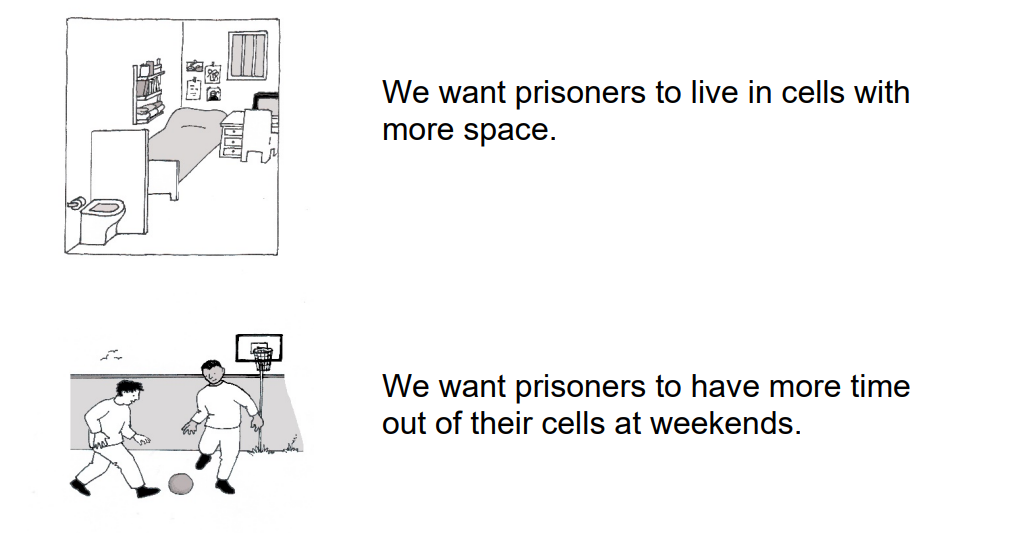Making our reports easier to read
Earlier this year, we began publishing easy read summaries of our reports on prison inspections. Tamsin Williamson, Communications and Publications Manager at HMI Prisons, led the project and explains here why this was so important to the organisation.
We listen to prisoners all the time. In fact, what detainees tell us runs through all of our inspections, whether it’s the prisoner survey, conversations with prisoners on the wings, one-to-one interviews, or discussions with prisoner groups about specific issues. We put the detainee voice at the heart of our reports and the assessments we make about outcomes for prisoners are clearly evidenced by what they have told us.
Yet the reports themselves are not really written with the particular needs of prisoners in mind.
We know that as many as 50% of prisoners are likely to be neurodivergent, and the lack of data means the figure could be much higher. This compares with around 15–20% of the general population. Many prisoners also have low levels of literacy or speak English as a second language, which means they struggle to understand essential written information while in custody. Statistics from the Ministry of Justice in August 2021 showed that 57% of adult prisoners had literacy levels below those expected of an 11-year-old. Not being able to read or write negatively affects prisoners, as we explored in our review of reading education in prisons, published with Ofsted in 2022:
‘Low reading ability limits prisoners’ ability to navigate life in prison. For example, they may struggle to access written information, such as family and legal correspondence, menus or faith-based texts, and struggle to fill out forms. This makes them more vulnerable and puts them at risk of becoming isolated. It also prevents them from fully participating in the purposeful activities available in the prison such as education or work.’
In our ‘Neurodiversity in the criminal justice system’ review, published with HM Inspectorate of Probation and HM Inspectorate of Constabulary and Fire & Rescue Services in July 2021, we said:
‘Many contributors to the review noted that the criminal justice system is reliant on the written word, and that many of the key documents are not accessible. Generally the language used, whether written or verbal, can be difficult to comprehend.’
Producing the neurodiversity review prompted us to question how well we were doing ourselves in sharing the findings of our inspections with prisoners.
Our reports often run to 70 pages and are aimed at a wide range of readers, from governors and the prison service, to academics, the media and MPs. Although we ask governors to make sure a copy goes into the prison library, we know that in some jails, prisoners get very little time out of cell and library access is often poor. This may make it very hard for prisoners to find out what we said about their prison and how what they told us during the inspection will help lead to positive change.
We want to rectify that. Over the last year we have worked with KeyRing, a national organisation promoting independent living through peer support and community networks, to develop Easy Read summaries of our reports. The summaries focus on the main concerns from our inspections – the big issues that really affect prisoners’ experience of detention and how it helps to prepare them for release. They explain what we did during the inspection, what we found, what we want the governor to do and, most importantly, what we want to happen now. Each sentence is written in 16-point font, is straightforward and easy to understand, and is supported by a simple illustration.

From May this year we began sending these summaries to prison governors, asking them to make sure they are available in places where prisoners will see them. That’s not just the library – we want the summaries to be shared on the wings, on in-cell laptops if prisoners have them, and through prison neurodiversity leads. We are also publishing the summaries on our website with the full report.
We’ve been encouraged by the positive feedback so far, particularly from the prison service and governors. We welcome feedback about the summaries, and will use it to make sure as many prisoners as possible, as well as their family and friends, are able to understand our inspection findings. Please send any comments to media@hmiprisons.gov.uk.
Some recent reports published with easy read summaries include:
